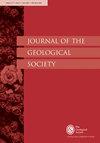白垩纪阿曼蛇绿岩Fizh地块高铝脚状铬铁矿的矿物及全岩地球化学:新生弧前环境中含水N-MORB熔体的成因
IF 3
3区 地球科学
Q2 GEOSCIENCES, MULTIDISCIPLINARY
引用次数: 0
摘要
阿曼蛇绿岩是世界上最大、暴露程度最高的蛇绿岩之一,拥有450个铬铁矿矿床。我们在这里报告一个新发现的铬铁矿矿床在瓦迪拉杰米在阿曼。该矿床赋存于双质包壳内,包壳被辉锌矿包围,由块状和浸染状铬铁矿类型组成。Rajmi橄榄岩代表了枯竭的上地幔岩石,经历了约20%的部分熔融,并经历了俯冲板块的熔体和流体的交代作用。它们显示出与伊豆-波宁-马里亚纳弧前橄榄岩相似的地球化学亲和力,支持它们在弧前环境中形成。拉杰米铬铁矿的Cr值较低,属于高铝型。它们的地球化学成分与大洋中脊玄武岩(MORB)型熔体结晶的铬铁矿相当。然而,这些高铝铬铁矿中的铬铁矿含有各种硅酸盐包裹体(即角闪洞、云母),表明其母岩浆具有含水和非典型MORB性质。结合岩石的矿物学和地球化学特征,我们认为Rajmi高铝铬铁矿的母熔体具有类似morb的亲和力,源于新生弧前地幔的部分熔融。专题收藏:本文是蛇绿岩、杂岩和蓝片岩收藏的一部分,可在:https://www.lyellcollection.org/topic/collections/ophiolites-melanges-and-blueschists补充材料:https://doi.org/10.6084/m9.figshare.c.6795689本文章由计算机程序翻译,如有差异,请以英文原文为准。
Mineral & whole–rock geochemistry of high-Al podiform chromitites in the Fizh Massif of the Cretaceous Oman ophiolite: Origin of hydrous, N–MORB melts in a nascent forearc setting
The Oman ophiolite is one of the largest and best-exposed ophiolites in the world with >450 chromitite deposits. We report here a newly identified chromitite deposit in the Wadi Rajmi in Oman. This deposit occurs within a dunitic envelope, which is surrounded by harzburgite, and consists of massive and disseminated chromitite types. The Rajmi peridotites represent depleted upper mantle rocks, which underwent >20% of partial melting and which experienced metasomatism by melts and fluids derived from a subducting slab. They demonstrate geochemical affinities similar to those of the Izu-Bonin-Mariana forearc peridotites, supporting their formation in a forearc environment. The Rajmi chromitites have low Cr# values and are classified as high-Al type. They have geochemical compositions comparable to those of chromitites crystallized from mid-ocean ridge basalt (MORB)-type melts. However, the chromites in these high-Al chromitites contain various silicate inclusions (i.e. amphibole, mica), indicating a hydrous and atypical MORB nature of their parental magmas. Combined with the mineralogical and geochemical characteristics of the country rocks, we posit that the parental melts of the Rajmi high-Al chromitites had a MORB-like affinity, derived from partial melting of a nascent forearc mantle.
Thematic collection:
This article is part of the Ophiolites, melanges and blueschists collection available at:
https://www.lyellcollection.org/topic/collections/ophiolites-melanges-and-blueschists
Supplementary material:
https://doi.org/10.6084/m9.figshare.c.6795689
求助全文
通过发布文献求助,成功后即可免费获取论文全文。
去求助
来源期刊

Journal of the Geological Society
地学-地球科学综合
CiteScore
6.00
自引率
3.70%
发文量
68
审稿时长
6-12 weeks
期刊介绍:
Journal of the Geological Society (JGS) is owned and published by the Geological Society of London.
JGS publishes topical, high-quality recent research across the full range of Earth Sciences. Papers are interdisciplinary in nature and emphasize the development of an understanding of fundamental geological processes. Broad interest articles that refer to regional studies, but which extend beyond their geographical context are also welcomed.
Each year JGS presents the ‘JGS Early Career Award'' for papers published in the journal, which rewards the writing of well-written, exciting papers from early career geologists.
The journal publishes research and invited review articles, discussion papers and thematic sets.
 求助内容:
求助内容: 应助结果提醒方式:
应助结果提醒方式:


